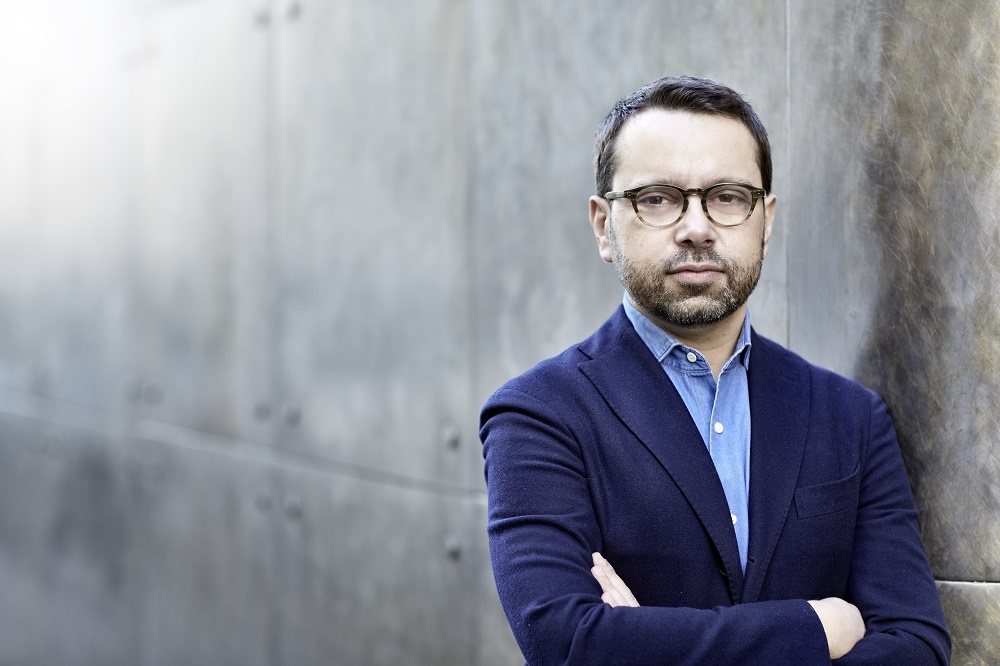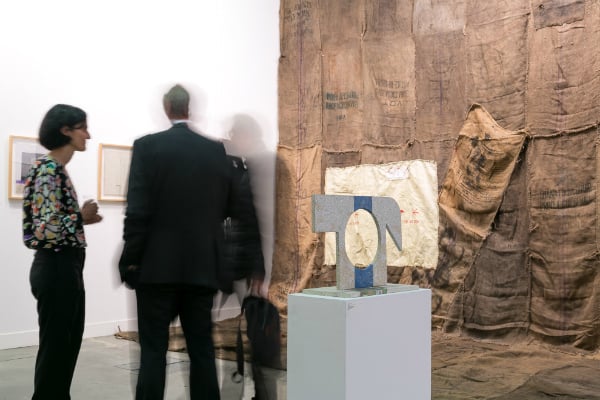Art Fairs
‘A Fair Is Not an Exhibition’ Says miart Director Alessandro Rabottini
With the big players buying stakes at regional art fair, what can smaller fairs do to stay relevant?

With the big players buying stakes at regional art fair, what can smaller fairs do to stay relevant?

Hili Perlson

The Milan International Fair of Modern and Contemporary Art, or miart, opens its 22nd edition this week, with public days running from March 31 – April 2, 2017. It’s the first edition under the leadership of the new artistic director Alessandro Rabottini, who took over from Vincenzo de Bellis after he was named visual art curator at the Walker Art Center last year, alongside Adrienne Edwards.
Having worked with de Bellis since 2013, Rabottini—who first joined as curatorial coordinator for the 2013-2015 editions, and served as deputy director for the 2016 edition—was instrumental in supporting the fair’s transformation from a sleepy regional affair to a vibrant, fashionable event befitting its host city.
The upcoming edition promises to push the boundaries on several fronts: with an impressive talks program and doubling the number of prizes to exhibitors, the fair is even moving towards becoming a producer with a commissions budget.
As a smaller fair, the challenge of miart is in finding the balance between the local and the international, something that is central to the fair’s identity. With his deep understanding of miart’s audience, Rabottini takes an editorial approach to achieving this equilibrium, comparing the fair in this interview with artnet News to a magazine—while the local flavor is the core attraction, the reach goes beyond what he calls the “Milan brand.”

Installation view of Jiri Kolar and Ibrahim Mahama at Then/Now, Miart 2016
Photo: Andrea Rossetti, Courtesy Lelong, Paris New York and Apalazzogallery, Brescia.
The fair has undergone a complete image revamp during the previous artistic director’s tenure, Vincenzo de Bellis, with whom you’ve worked since 2013. What are some of the updates you’ve introduced in your first edition as the fair’s artistic director?
The first thing I wanted to do was to consolidate and expand the structure that I inherited, since I have always felt a part of it. Also, even if I have always worked as curator for public institutions, I believe that a fair is not an exhibition and I don’t see it as an authorial project. It’s more like taking on a magazine: you have a readership and a number of advertisers, you look at its architecture and see how you want to address certain issues that are shaping the current landscape, and you look for the right people to tell the right stories.
Given the fact that miart puts a strong focus on the dialogue between modern and contemporary art, my curatorial team and I have worked hard on consolidating the extent of our chronological offer, and the result is that in a fair which is still relatively contained (with an overall 174 exhibitors) people can find works from the beginning of the last century to the most recent generations of artists. And this is essential to me, since each different section—from “Emergent” to “Masters”—can activate a different audience.
Curated sections are becoming increasingly important to art fairs. For miart in particular, they were key in reinventing the fair’s image. What are some of the highlights you’re looking forward to this year?
I am excited to see the further developments to the format of “THENnow”, which is a curated section that, until last year, saw pairings between a historical artist and a younger position as the result of the collaboration between two galleries.
We took that format and turned into “Generations”, which in this new incarnation is curated by Douglas Fogle and Nicola Lees: this section still sees two galleries invited to share the same booth, but we wanted to break the binary opposition of “past vs present” and invite them to confront artists from different generations, regardless of their age. Artists perceive history in a different way and, in the space of a few years, we have witnessed radical changes in terms of language and sensibility, so we wanted to ask, what defines a generation? Does this categorization still exist in our current understanding of artistic events?
Also, the section “Decades” will happen for the second consecutive year and, curated by Alberto Salvadori, is designed as a trajectory throughout the 20th century: nine galleries stage nine booths, each with a project conceived to represent one decade. It will be like taking a time machine.
miart is also quite unique in its inclusion of a section for collectible design. How do the two elements, art and design, come together at the fair?
We have experienced in the past few editions a more and more intense dialogue between art collectors and design collectors, and to me it makes perfect sense that in a city like Milan, that a few days after miart will host the Salone del Mobile, we contextualize limited edition design in an art fair. I am very proud of the selection of galleries that our curator Domitilla Dardi has brought together for the section “Object,” and the presence of leading galleries in the field like Nilufar, Giustini Stagetti Galleria O, Dimoregallery, Rossella Colombari, Erastudio Apartment-Gallery, and Luisa Delle Piane, only to mention a few, makes me think that the osmosis with the art context is more and more productive.
In an interview with artnet News last year, de Bellis argued for the smaller, local art fairs over the mega events. Now, MCH, the company that manages the Art Basel fairs is getting involved with regional fairs, starting with India and Düsseldorf. What does it mean for fairs like miart?
It’s hard to predict what will happen in the future, and this is true for the art market and for every single aspect of our connected existences. The core of a project like miart is to always find new ways to connect an international audience to the specificity of a local context, and in this case Milan is facing an extremely exciting moment in its history. What can be done with this unique blend of international scope and local identity is one of the challenges for the future, and we are not talking just about miart. I think that answers will arrive from the ultimate protagonists of what we call an “art fair,” which are the collectors and the galleries. They will tell us how formats and contexts will have to change in order to serve in the best way the developments of the art market.
And I am convinced that people wanting to spend their money on artworks follow unpredictable paths, since through collecting they respond to artists’ visions, which are primordial in their very nature and unpredictable in the shapes they take.
What is the Italian market like? Do local collectors tend to take risks?
What I like about Italian collectors is that they are committed. I have seen collectors in Italy buying works from artists at the very beginning of their careers without looking at their CVs, and I am talking about difficult, challenging works. They tend to have a very personal take on the acquisitions, which lead to eclectic and diverse collections; you will hardly find an Italian collection with a corporate feeling.
I always learn a lot from them since they travel extensively and are well informed but, at the end of the day, they have this capacity to ground their acquisitions within a wider, historical context. This is maybe the reason why they tend to listen to the voice of the work itself, regardless of a strategic approach to collecting, so that a conceptual photo-based work can sit next to a beautiful figurative painting.
In fact, my understanding of their independent view encouraged me to develop a brand-new section named “On Demand,” where we encouraged galleries to bring works that are context-related and that need to be “activated” by the owner or the viewer, such as site-specific installations, performative sculptures, commissions, and even projects still to be realized.
For this section we managed to create a new €10.000 prize, which will support a future project by the awarded artist, such as a catalog or a solo exhibition at an institution, or the participation in a biennial. In this way, and thanks to the production company Snaporazverein, miart will be in the position to perform the function of a co-producer, way beyond its temporal and spatial limits.
Milan, and Italy in general, has a slew of private foundations that stage some of the most exciting exhibitions for contemporary artists in Europe, and seem to be a driving force in the market as well. To what extent does miart work together with private foundations, and the city’s public institutions?
A lively fair can not exist without a lively context, and what we can call the “miart brand”—a fair which is sophisticated, eclectic, diverse and reasonable in size—is a direct emanation of the very nature of Milan.
And despite the growing number of art initiatives, in Milan, the concept of “art community” still holds a meaning, which brings us all to collaborate with each other. Thanks to the support of the Municipality of Milan and its Division of Culture, miart coordinates the Milano Art Week program, which sees the participation of the major players in the city, from the Fondazione Prada to Hangar Bicocca, from Palazzo Reale to the Museo del Novecento and the PAC, up to the newly founded FM–Centro per l’Arte Contemporanea and Fondazione Carriero, only to name a few.
There will be so much to see that, for the very first time, we had to stretch the beginning of the program to start from Monday, March 27, even if miart will have its preview only on March 30.
This basically means that what happens in Milan with the Fashion Week and the Design Week is now happening with modern and contemporary art as well, and I am honored to serve such an energetic and inspiring city.